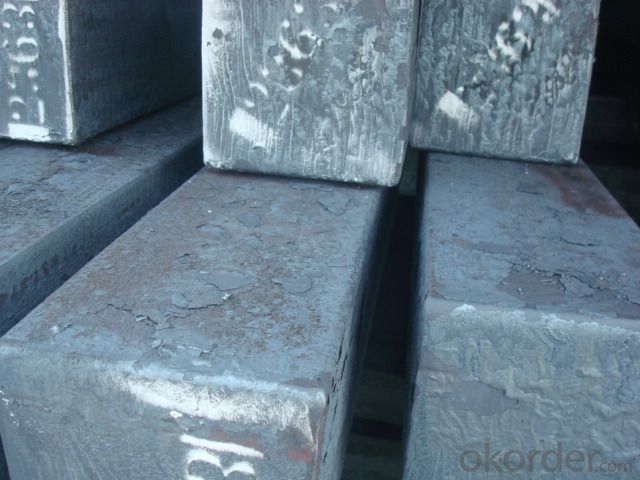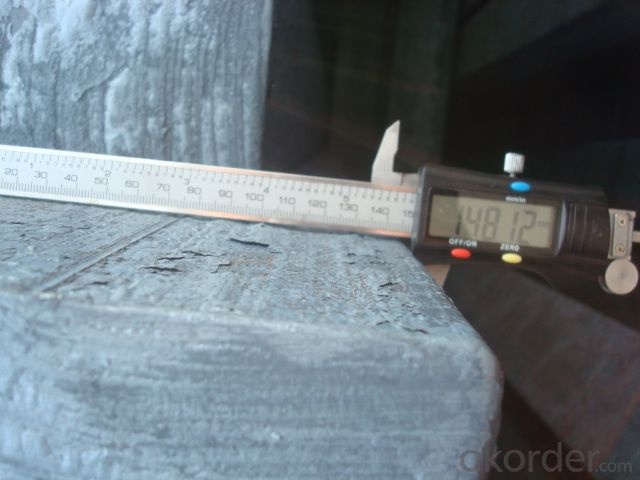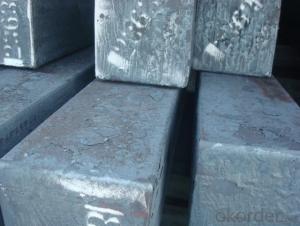Steel Billet Hot Rolled Q235 in Amazing Price
- Loading Port:
- Tianjin
- Payment Terms:
- TT OR LC
- Min Order Qty:
- 1000 m.t.
- Supply Capability:
- 50000 m.t./month
OKorder Service Pledge
OKorder Financial Service
You Might Also Like
1.Structure of Steel Billet
Steel billet(ingot) by cogging or breakdown of semi-finished products, is the raw material of all kinds of steel mill. Billet section of square, round, flat, rectangular and abnormity of several kinds of, mainly related to the shape of rolled products.
2.Main Features of Steel Billet
Rectangular billet continuous casting billet and mainly general carbon steel, low carbon low silicon cold-rolled material, high quality carbon structural steel, high strength low alloy steel, special steel, etc.
The billet is mainly divided into two kinds from the shape:
Slab: cross section width and height of the ratio of the larger, mainly used for rolling plate.
Billet: equal cross section width and height, or a huge difference, mainly used for rolling steel, wire rod. ,
Steel billets have distinct characteristics as compared with already furnished steel bars and products. Billets have a specific grain structure, which enables the metal to be processed more intricately. Steel billets are also known for their malleability and ductility, especially when exposed to varying temperatures during shaping and molding.
3.Steel Billet Images


4. Steel Billet Specification
Hot rolled billet steel
Size: 50x50mm-180x180mm
Steel Grade: 3SP, 5SP,Q195,Q235,Q255,Q275 Length:3m-12m
MOQ: 1000MT/size
Payment term: TT or LC
Packing: in bulk , bundle
Shipment: by container , bulk vessel
Packaging Details: bundles with steel strips or as customers's requirements
Delivery time: 15-30 days after the deposit
Loading port:Tianjin, or other port China
Origin :China
Inspection:Third party inspection before loading.
5.FAQ
We have organized several common questions for our clients,may help you sincerely:
1) How about your company?
A world class manufacturer & supplier of castings forging in carbon steel and alloy steel,is one of the large-scale professional investment casting production bases in China,consisting of both casting foundry forging and machining factory. Annually more than 8000 tons Precision casting and forging parts are exported to markets in Europe,America and Japan. OEM casting and forging service available according to customer’s requirements.
2) How to guarantee the quality of the products?
We have established the international advanced quality management system,every link from raw material to final product we have strict quality test;We resolutely put an end to unqualified products flowing into the market. At the same time, we will provide necessary follow-up service assurance.
3) How long can we receive the product after purchase?
In the purchase of product within three working days, We will arrange the factory delivery as soon as possible. The pecific time of receiving is related to the state and position of customers.Commonly 7 to 10 working days can be served.
4)I want to buy products, but I can’t find them in your website.
We have some products not listed on the website. If you can’t see what you are looking for, email us and we will work with you to get you what you want.
How about the guaranty for your products?
A: It depends on the working environment. Generally speaking, the guarantee period for safety shoes is 6 months.
- Q:What is the size range of steel billets?
- The size range of steel billets can vary depending on the specific requirements of the industry or application. However, in general, steel billets are typically produced in square or rectangular shapes, with dimensions ranging from 100mm to 200mm in width and height, and lengths ranging from 3 to 12 meters. These dimensions can be customized based on the intended use of the billets, such as for forging, rolling, or further processing into finished steel products.
- Q:How are steel billets used in the production of beams and columns?
- Beams and columns require steel billets, which are semi-finished steel products typically in square or rectangular shapes. They are created through casting, where liquid steel is poured into molds and allowed to solidify. After solidifying, the steel billets undergo further processing to become beams and columns. This involves heating, rolling, and shaping. To begin, the billets are heated in a furnace to increase their malleability and ease of shaping. This process is called soaking. Then, the billets are passed through rolling mills under high pressure to achieve the desired dimensions. For beams, the steel billets are rolled into long, slender shapes with either an I or H cross-section. These beams provide structural support and handle heavy vertical loads, transferring them to the columns or other supporting structures. On the other hand, columns are produced by rolling steel billets into cylindrical shapes. These cylindrical billets are further processed to achieve the desired diameter and length. Columns are crucial for building construction, as they provide vertical support and evenly distribute the structure's weight. In conclusion, steel billets are essential in the production of beams and columns. Through heating, rolling, and shaping processes, these billets are transformed into sturdy and reliable structural components necessary for constructing buildings.
- Q:What are the potential applications of steel billets in the food and beverage aftermarket?
- Steel billets have a wide range of potential applications in the food and beverage aftermarket. One potential application is in the production of food processing equipment. Steel billets can be used to manufacture machinery and equipment that is used in food processing plants, such as conveyor belts, food mixers, and cutting tools. The durability and strength of steel make it a suitable material for these applications, as it can withstand the rigors of heavy use and maintain its integrity even in harsh conditions. Another potential application of steel billets in the food and beverage aftermarket is in the construction of storage tanks and containers. Steel is known for its corrosion resistance, making it ideal for storing various food and beverage products. Steel billets can be used to manufacture tanks and containers that can safely store liquids such as water, juices, and alcoholic beverages. These steel tanks can also be insulated to ensure temperature control, which is crucial in preserving the quality of perishable products. Furthermore, steel billets can be used in the production of kitchen equipment and utensils. Steel is a hygienic material that is easy to clean and maintain, making it suitable for use in commercial kitchens and food preparation areas. Steel billets can be shaped into various kitchen utensils such as knives, pans, and cooking pots, which are essential tools in the food and beverage industry. Steel utensils are known for their durability and heat conductivity, which ensures even cooking and efficient food preparation. Overall, the potential applications of steel billets in the food and beverage aftermarket are vast. From food processing equipment to storage tanks and kitchen utensils, steel billets provide a reliable and versatile material for various industries within the food and beverage sector. Its strength, durability, and hygienic properties make it a valuable resource in ensuring the safe and efficient production, storage, and preparation of food and beverages.
- Q:What are the common quality control measures for steel billets?
- Common quality control measures for steel billets include: 1. Dimensional checks: This involves measuring the length, width, and thickness of the billets to ensure they meet the specified tolerances. Any deviations from the required dimensions can indicate a potential quality issue. 2. Visual inspection: Billets are visually inspected to identify any surface defects such as cracks, scratches, or dents. This is typically done using visual aids like magnifying glasses or cameras to ensure the surface is free from any imperfections. 3. Chemical composition analysis: A sample is taken from the billet and analyzed to determine its chemical composition. This is important as it ensures that the steel meets the specified requirements in terms of the percentage of different elements, such as carbon, manganese, and sulfur. Deviations from the desired composition can affect the steel's strength and other properties. 4. Mechanical testing: Various mechanical tests are conducted on the billets to assess their strength, ductility, and other mechanical properties. These tests may include tensile testing, hardness testing, impact testing, and bend testing. The results are compared to the specified standards to ensure the billets meet the required mechanical properties. 5. Ultrasonic testing: This non-destructive testing method is used to detect internal defects or irregularities within the billets. Ultrasonic waves are sent through the billet, and any reflected waves or changes in wave patterns can indicate the presence of defects such as voids, inclusions, or cracks. 6. Heat treatment verification: Steel billets often undergo heat treatment processes to enhance their properties. Quality control measures involve verifying that the billets have been properly heat treated by conducting tests such as hardness testing or microstructure analysis. 7. Surface finish inspection: The surface finish of the billets is checked to ensure it meets the specified requirements. This can include measuring the surface roughness or visually inspecting for any deviations from the desired finish, such as scale, rust, or uneven surfaces. By implementing these quality control measures, steel manufacturers can ensure that the billets they produce meet the required standards and specifications, leading to high-quality end products.
- Q:How are steel billets used in the production of axles?
- Steel billets are an indispensable element when manufacturing axles, as they serve as the raw material for their production. The initial step in the production process involves heating the steel billets to a specific temperature, which enhances their malleability. This heating process, known as forging or hot rolling, enables the billets to be molded and manipulated into the desired axle shape. Once the billets have reached the appropriate temperature, they are placed in either a forging press or a rolling mill. In the forging process, the billets are subjected to high pressure, resulting in the desired axle shape. This process may involve multiple steps, such as hammering, pressing, or extrusion, to achieve the desired dimensions and shape. Following the forging process, the axle typically undergoes heat treatment to enhance its durability and strength. This involves heating the axle to a specific temperature and then rapidly cooling it through a process called quenching. The heat treatment process aids in improving the axle's hardness and resistance to wear and tear. After the forging and heat treatment processes, the axles may undergo further procedures such as machining, grinding, or finishing. These additional steps are carried out to achieve the required surface finish and dimensional accuracy, ensuring that the axles meet the necessary specifications and can seamlessly integrate into the final product. In conclusion, steel billets play a crucial role in axle production, serving as the starting point for the manufacturing process. They undergo heating, forging, and shaping to create the desired axle form. The resulting axles are then subjected to heat treatment and additional processes to meet specifications. Steel billets are essential for producing top-quality and long-lasting axles, which are critical components in various industries, including automotive, railway, and heavy machinery.
- Q:What are the main factors affecting the weldability of steel billets?
- The main factors affecting the weldability of steel billets include the composition of the steel, the presence of impurities, the presence of alloying elements, the size and shape of the billets, and the heat treatment of the steel.
- Q:What are the different types of steel billet rolling mill defects?
- There are several types of steel billet rolling mill defects that can occur during the rolling process. These defects can have various causes and can affect the quality and performance of the final product. Some of the common types of defects include: 1. Surface defects: These defects are visible on the surface of the rolled billet and can include scratches, cracks, pits, and scale. Surface defects can be caused by improper handling, inadequate lubrication, or excessive rolling pressures. 2. Shape defects: Shape defects refer to the deviations from the desired shape of the billet. These can include bowing, twisting, or excessive tapering. Shape defects can be caused by uneven cooling, improper alignment of the rolling mill, or incorrect rolling parameters. 3. Internal defects: Internal defects are defects that are not visible on the surface but can affect the structural integrity of the billet. These defects can include segregation, porosity, and inclusions. Internal defects can be caused by the presence of impurities in the raw material, improper heating or cooling, or inadequate quality control measures. 4. Dimensional defects: Dimensional defects refer to deviations from the desired dimensions of the billet, such as variations in length, width, or thickness. These defects can be caused by improper calibration of the rolling mill, incorrect rolling parameters, or inadequate quality control measures. 5. Metallurgical defects: Metallurgical defects are defects that occur due to improper metallurgical processes during rolling. These defects can include grain size variations, improper grain flow, or undesirable microstructure. Metallurgical defects can be caused by improper temperature control, inadequate alloying, or insufficient heat treatment. It is important for steel billet rolling mills to have proper quality control measures in place to identify and rectify these defects. Regular inspections, testing, and monitoring of the rolling process can help to minimize these defects and ensure the production of high-quality steel billets.
- Q:What is the global production capacity of steel billets?
- The global production capacity of steel billets is difficult to determine precisely as it constantly fluctuates due to various factors such as demand, market conditions, and technological advancements. However, it is estimated to be in the range of several hundred million metric tons annually.
- Q:Are steel billets used in the manufacturing of oil and gas pipelines?
- Oil and gas pipelines are commonly manufactured using steel billets. These billets are semi-finished products that are created through continuous casting, a process that solidifies molten steel into a rectangular form. They are utilized as the initial material for various steel products, specifically pipes for the oil and gas sector. The manufacturing process for oil and gas pipelines involves multiple steps, one of which is the production of seamless or welded steel pipes. Steel billets are heated and then rolled into tubes or pipes through a procedure known as pipe making. In the case of seamless pipes, the heated billet is pierced to create a hollow shell, which is subsequently elongated and shaped into a pipe. On the other hand, welded pipes are formed by rolling and welding a flat steel plate to construct a tube. The utilization of steel billets in pipeline manufacturing is favored due to steel's outstanding mechanical properties, which include strength, durability, and resistance to corrosion. These attributes make steel an ideal material for pipelines that must endure high-pressure environments and harsh conditions. Moreover, steel billets can be tailored in terms of size, shape, and composition to satisfy the specific requirements of each pipeline project. To summarize, steel billets play a critical role in the production of oil and gas pipelines. They serve as the raw material that undergoes transformation into seamless or welded pipes, enabling the transportation of oil and gas over long distances. The use of steel guarantees the dependability and integrity of these pipelines, establishing them as indispensable components of the oil and gas industry.
- Q:What is the difference between steel billets and steel ingots?
- Steel billets and steel ingots are both intermediate forms of steel used in the manufacturing process, but they differ in terms of their shape and size. Steel billets are smaller, square or round-shaped solid bars, typically measuring around 2 to 7 inches in diameter, and are produced through continuous casting or hot rolling processes. On the other hand, steel ingots are larger, rectangular or cylindrical-shaped blocks, with dimensions ranging from a few inches to several feet, and are usually produced through the traditional casting method. The main distinction lies in their size and shape, with billets being smaller and more manageable for further processing, while ingots are larger and require additional steps, such as forging or rolling, to be transformed into usable steel products.
1. Manufacturer Overview |
|
|---|---|
| Location | |
| Year Established | |
| Annual Output Value | |
| Main Markets | |
| Company Certifications | |
2. Manufacturer Certificates |
|
|---|---|
| a) Certification Name | |
| Range | |
| Reference | |
| Validity Period | |
3. Manufacturer Capability |
|
|---|---|
| a)Trade Capacity | |
| Nearest Port | |
| Export Percentage | |
| No.of Employees in Trade Department | |
| Language Spoken: | |
| b)Factory Information | |
| Factory Size: | |
| No. of Production Lines | |
| Contract Manufacturing | |
| Product Price Range | |
Send your message to us
Steel Billet Hot Rolled Q235 in Amazing Price
- Loading Port:
- Tianjin
- Payment Terms:
- TT OR LC
- Min Order Qty:
- 1000 m.t.
- Supply Capability:
- 50000 m.t./month
OKorder Service Pledge
OKorder Financial Service
Similar products
New products
Hot products
Hot Searches
Related keywords





























